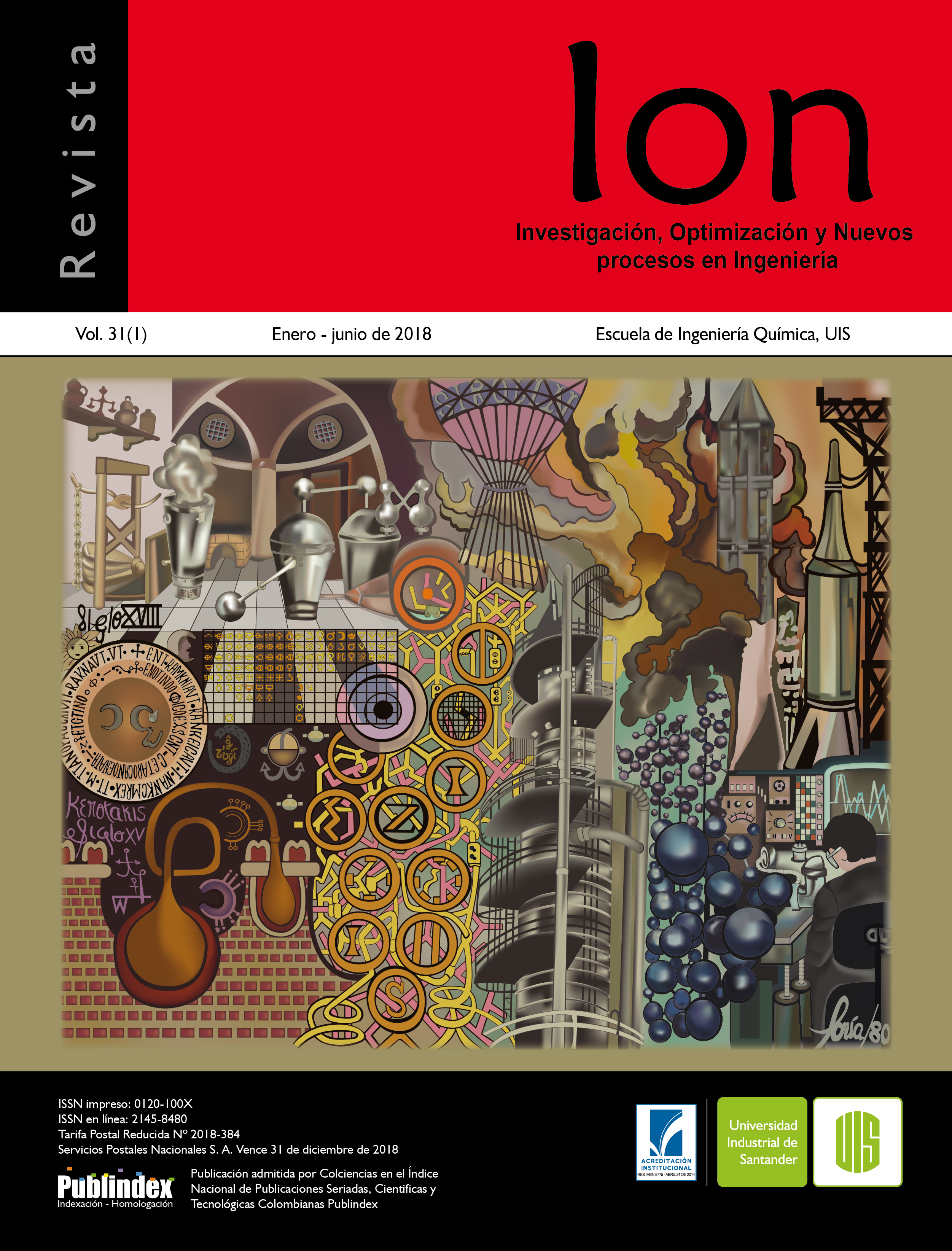Articles
Organic Acids of Resin Glycosides from Three Ipomoea Species (Convolvulaceae)
Published 2018-09-28
Keywords
- Convolvulaceae,
- Ipomoea,
- organic acids,
- resin glycosides,
- gas chromatography
How to Cite
Osorio, N., Charry, P. A., Rios-Vásquez, E., & Castañeda-Gómez, J. F. (2018). Organic Acids of Resin Glycosides from Three Ipomoea Species (Convolvulaceae). Revista ION, 31(1), 55–58. https://doi.org/10.18273/revion.v31n1-2018009
Abstract
Esterifying residues from resin glycosides from three Ipomoea species (Ipomoea trífida, Ipomoea purpurea and Ipomoea hederifolia) were identified by gas chromatography and mass spectrometry (CG-MS).These species are invasive of coffee plants and were collected in Quindío, Colombia. First, the extracts with resin glycosides were degraded through saponification to liberate of organic acids soluble in ether and Chloroform. Decanoic, dodecanoic and hexadecanoic acids were the most common esterifying residues from the studied species.
Downloads
Download data is not yet available.
References
[1] CENICAFE. Descripción de malezas en plantaciones de café. Manizales, Colombia: Gómez AA, Rivera PJH; 1987.
[2] Pereda-Miranda R, Rosas-Ramírez D, Castañeda-Gómez J. Progress in the chemistry of organic natural products. Switzerland: Kinghorn AD, Falk H, Kobayashi J Eds; 2010. P. 77-152.
[3] Castañeda J, Charry P, Pereda R. Empleo de métodos analíticos modernos para el aislamiento y la identificación de resinas glicosídicas de la familia Convolvulaceae. Revista de investigaciones de la Universidad del Quindío. 2015;24(1):19-29.
[4] Corona B, Pereda R. Morning Glory Resin Glycosides as Modulators of Antibiotic Activity in Multidrug-Resistant Gram-Negative Bacteria. Planta Med. 2012;78:128–31.
[5] Castañeda J, Figueroa G, Jacobo N, Pereda R. Purgin II, a resin glycoside ester- type dimer and inhibitor of multidrug efflux pumps from Ipomoea purga. J. Nat. Prod. 2013;76:64−71.
[6] Cruz S, CastañedaJ, Rosas D, Fragoso M, Figueroa G, Lorence A. Resin Glycosides From Ipomoea alba Seeds as Potential Chemosensitizers in Breast Carcinoma Cells. J Nat Prod. 2016;79(12):3093–104.
[7] Corona B, Rosas D, Castañeda J, Aparicio MA, Fragoso M, Figueroa G. Resin glycosides from Ipomoea wolcottiana as modulators of the multidrug resistance phenotype in vitro. Phytochemistry. 2016;123:48–57.
[8] Cruz S, Castañeda J, Figueroa G, Mendoza AD, Lorence A, Pereda R. Mammalian Multidrug Resistance Lipopentasaccharide Inhibitors from Ipomoea alba Seeds. J Nat Prod. 2012;75(9):1603–11.
[9] Castañeda J, Rosas D, Cruz S, Fragoso M, Pereda R. HPLC-MS profiling of the multidrugresistance modifying resin glycoside content of Ipomoea alba seeds. Brazilian Journal of Pharmacognosy. 2017;27:434-39.
[10] Pereda R, Mata R, Anaya AL, Wickramaratne DBM, Pezzuto JM, Kinghorn AD. Tricolorin A, Major Phytogrowth Inhibitor from Ipomoea tricolor. J. Nat. Prod. 1993;56:571.
[11] Peterson JK, Harrison HF. Isolation of Substance from Sweet Potato (Ipomoea batatas) Periderm Tissue that Inhibits Seed Germination. J Chem Ecol. 1991;17:943.
[12] Fang Y, Chai W, Chen S, He Y, Zhao L, Peng J, Huang H, Xin B. On the Structure of Calonyctin A, a Plant Growth Regulator. Carbohyd Res.1993;245(2):259-70.
[13] Castañeda Gómez J, Pereda Miranda R. Resin Glycosides from the Herbal Drug Jalap (Ipomoea purga). J Nat Prod. 2011;74(5):1148–53.
[2] Pereda-Miranda R, Rosas-Ramírez D, Castañeda-Gómez J. Progress in the chemistry of organic natural products. Switzerland: Kinghorn AD, Falk H, Kobayashi J Eds; 2010. P. 77-152.
[3] Castañeda J, Charry P, Pereda R. Empleo de métodos analíticos modernos para el aislamiento y la identificación de resinas glicosídicas de la familia Convolvulaceae. Revista de investigaciones de la Universidad del Quindío. 2015;24(1):19-29.
[4] Corona B, Pereda R. Morning Glory Resin Glycosides as Modulators of Antibiotic Activity in Multidrug-Resistant Gram-Negative Bacteria. Planta Med. 2012;78:128–31.
[5] Castañeda J, Figueroa G, Jacobo N, Pereda R. Purgin II, a resin glycoside ester- type dimer and inhibitor of multidrug efflux pumps from Ipomoea purga. J. Nat. Prod. 2013;76:64−71.
[6] Cruz S, CastañedaJ, Rosas D, Fragoso M, Figueroa G, Lorence A. Resin Glycosides From Ipomoea alba Seeds as Potential Chemosensitizers in Breast Carcinoma Cells. J Nat Prod. 2016;79(12):3093–104.
[7] Corona B, Rosas D, Castañeda J, Aparicio MA, Fragoso M, Figueroa G. Resin glycosides from Ipomoea wolcottiana as modulators of the multidrug resistance phenotype in vitro. Phytochemistry. 2016;123:48–57.
[8] Cruz S, Castañeda J, Figueroa G, Mendoza AD, Lorence A, Pereda R. Mammalian Multidrug Resistance Lipopentasaccharide Inhibitors from Ipomoea alba Seeds. J Nat Prod. 2012;75(9):1603–11.
[9] Castañeda J, Rosas D, Cruz S, Fragoso M, Pereda R. HPLC-MS profiling of the multidrugresistance modifying resin glycoside content of Ipomoea alba seeds. Brazilian Journal of Pharmacognosy. 2017;27:434-39.
[10] Pereda R, Mata R, Anaya AL, Wickramaratne DBM, Pezzuto JM, Kinghorn AD. Tricolorin A, Major Phytogrowth Inhibitor from Ipomoea tricolor. J. Nat. Prod. 1993;56:571.
[11] Peterson JK, Harrison HF. Isolation of Substance from Sweet Potato (Ipomoea batatas) Periderm Tissue that Inhibits Seed Germination. J Chem Ecol. 1991;17:943.
[12] Fang Y, Chai W, Chen S, He Y, Zhao L, Peng J, Huang H, Xin B. On the Structure of Calonyctin A, a Plant Growth Regulator. Carbohyd Res.1993;245(2):259-70.
[13] Castañeda Gómez J, Pereda Miranda R. Resin Glycosides from the Herbal Drug Jalap (Ipomoea purga). J Nat Prod. 2011;74(5):1148–53.

